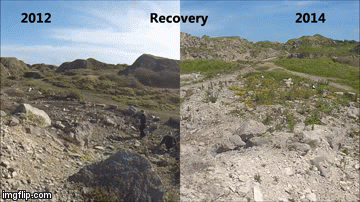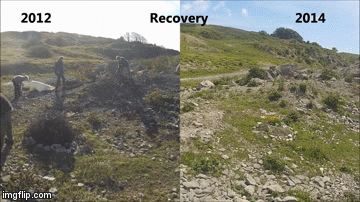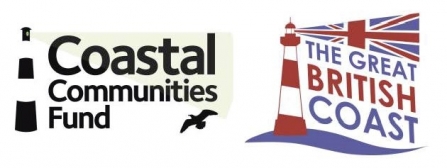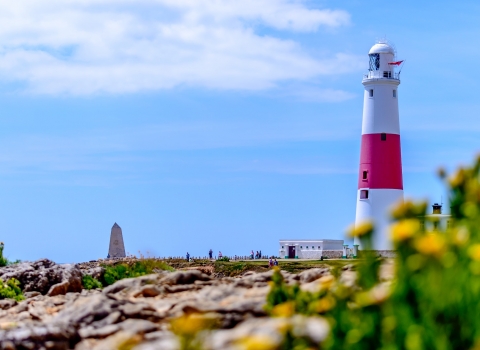Silver studded blue butterfly © Mark Heighes
Portland Quarries Nature Park
Portland: A landscape produced over millions of years, hued by industry, etched with artwork, steeped in history and renewed by ecology
Portland Quarries Nature Park is a partnership of organisations, with their origins in industry, geology, ecology and arts. Bringing all these different streams together to help interpret the landscape, allow people access, where suitable, and conserve these fascinating sites.
Many of the sites within the park are today protected as Sites of Special Scientific Interest. They are important for geology, flora and fauna. The Nature Park sites have local significance and a culture built around them over hundreds of years of toil with the rock. Today they exhibit artwork which has been crafted into the stone over the last forty years since quarrying finished on some sites.
What makes Portland so special?
The PQNP Partnership
Portland Quarries Nature Park (PQNP) is a network of important coastal heritage sites. Over the past decade a partnership of organisations working with the local community, have restored these ex-quarries from what were public eye-sores, to areas that can showcase Portland’s world-class industrial, cultural and natural heritage.
PQNP provides a unique opportunity for visitors to explore Portland’s famous stone and natural heritage. It aims to use the island’s internationally important natural assets to contribute to the local economy in a sustainable way.
Butterflies, beach and beauty: Portland's ecology
The disused quarries, in parts, have now been reclaimed by nature, whether on the undisturbed ground or within the quarried areas. The thin nutrient poor soils give rise to rare limestone grassland, with endemic species such as the early gentian. These are flower rich habitats with species such wild thyme, pyramidal and bee orchids. The quarried areas are being slowly recolonised with species such as horseshoe vetch, small scabious and squinancywort, thus extend the calcareous grassland.
These flower rich grasslands provide brilliant nectaring and egg laying opportunities, as well as larval foodplants, for a range of invertebrates. One rare species of butterfly which depends on this is the silver studded blue, with its larvae enjoying bird’s foot trefoil and the close association with black ants that live under the stones.
The exposed faces of beach walls and overburden provide habitat for a variety of reptiles like common lizards - as well as providing roosting habitat for birds such as little owls, and spots for bats to hide away. Lichens, some uncommon, flourish on these exposed rocks, together with the extremely rare liverwort blackwort.
The scrub areas provide nesting for birds, such as stonechats, and provide important cover for the migrant birds as they leave or arrive on our shores. There are however, some non-native shrubs such as cotoneaster and buddleia which have a detrimental effect on the grassland and the fauna which depend on it. There is on-going control programme in place for this.
Jurassic roots: Geology
The geology of Portland varies from Kimmeridge clays through Portland sands to Portland and Purbeck limestone. It was predominantly laid down in the Jurassic period. The thin top beds of Purbeck stone were formed in very shallow lagoons, sometimes even ripple marks can be seen fossilised. Amongst this bed we find large holes in the stone, left by trees as they became submerged in the lagoons and swamps 145 million years ago.
The Portland stone below is what has made the Isle famous. It was formed in shallow tropical seas and is a type of oolitic limestone. It was made when small fragments of shell or sand became coated with calcium carbonate in concentric layers. These were then buried as more calcium carbonate was deposited on top and around them. The stone beds are also particularly rich in fossils such as ammonites. This Portland series of stone has several different layers; Roach, Whitbed and Basebed, all of which have varying qualities. The best quality for building being the Whit and Base beds.
At the base of Portland on the north side we see the exposure of the Portland sands and Kimmeridge clays.
Art on the Isle: Sculptures
The Portland Sculpture and Quarry Trust project in Tout began in 1983, a year after 30,000 tons of boulders were extracted from the quarry stone walls for sea defences in West Bay. Since then, the remaining landscape has been protected and artists have given back to the quarry through their creativity, saving it from further mineral extraction.
Work by national and international artists creates vantage points, to learn about sculpture, geology, ecology and enjoy the sense of history and time. The works are carved into rock faces, extracted boulders, constructed in shale, or worked from the landscape itself. Stone carving and sculpture courses are held in the Trust’s open-air workshop.
Antony Gormley, when working on his sculpture ‘Still Falling’, summed up many peoples’ feelings about this special quarry. He said: “The quarry itself is a powerful inspiration and tribute to the small bands of men that worked it, using blocks and wedges as well as natural layering and fissuring to cut the stone. Their technique, using neither complex machinery nor explosives, was a mixture of science, intuition and hard teamwork that is a model for us all. Working with stone is a fine job. Working on stone in a quarry is a challenge. You have to consider the material as part of the place, as part of the earth.”
Tout is a unique place where sculptures are carved into a landscape left by the quarrymen and mellowed by nature. You can find out more here.
Set in Stone: Portland's quarrying history
Portland has been quarried for nearly 1,000 years, initially providing material for local buildings such as Exeter Cathedral and Portland Castle. It wasn’t until the 1600’s when Portland stone began to travel to London for use in building projects, that quarrying really took off.
Initially the stone would have been worked by hand by family quarrying enterprises, in thin strips of land. They would have used natural fissures in the rock to break and split the stone, to then extract the best stone below. The overburden materials would have been retained behind dry stone walls called beaches, these walls can be seen at various points around the park as well as dry stone bridges. The quarried material would have been moved down the gullies to the coast path eventually making its way down to the harbour, latterly via the merchants railway built in the 1800’s.
Quarrying continues today across the island, it is now a highly specialised industry with large machinery, often working under the ground rather than using open quarries as was once the case.
Finding your way: Trails and maps
The quarries are former industrial landscapes, so please follow all on site safety information. Please adhere to site specific information relating to dog walking and always remove dog mess from site.

Portland recovery works DWT
This photo shows some of the restoration work we have been carrying out on the Isle, together with our dedicated volunteers. You can clearly see the quarry landscape rejuvenation.

Portland recovery works by DWT
Again, clear differences can be seen between the two photos, where we have been working to restore this important natural landscape. It clearly shows what a difference even a couple of years can make. Please get in touch if you'd like to volunteer with us.

Coastal Communities Logo




